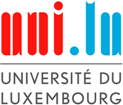General Information
- To give Ph.D. students the opportunity to present their fields of research
and some topics and problems studied in those fields.
The usual audience of the Doctorands Seminar is composed by Ph.D. students,
young researchers and professors of the
Mathematics Research Unit. The atmosphere is informal, so that all participants
can ask the questions they want.
Comments and suggestions on the presentations are also highly encouraged.
- To provide a good general mathematical background, in relation with the research interests of groups of Ph.D. students and other participants of the Doctorands Seminar. In this perspective, the Doctorands Seminar proposes all over the academic year series of introductory minicourses, held by the young researchers of the Mathematics Research Unit.
Time and venue
The sessions take place every Monday from 15:45am to 17:15am, in the room A16 located in the main building on the campus of Kirchberg.Aim
Dedicated to Ph.D. students, the Doctorands Seminar is an important part of the research training offered at the Mathematics Research Unit of Luxembourg University. The Doctorands Seminar has a twofold objective:Who can be a speaker?
All contributions for talks or minicourses are welcome, including from people external to Luxembourg Mathematics Research Unit!If you want to make a presentation, please provide the organizers with a title and an abstract of your talk. Lecture notes in any form are welcome as well.
Organisers
Talks
| May 13, May 23, & June 3, 2013 | Dr. Matteo Tommasini
, Orbifolds and 2-categories
Abstract: A well known issue in mathematics is that of modelling geometric objects whose points have non-trivial (finite) groups of automorphisms. Such ideas arise naturally in problems of moduli spaces and whenever we want to describe quotients of manifolds by (finite) groups of automorphisms that do not act freely. In topology and differential geometry the standard approach to these objects is through orbifolds. Currently there are at least 3 main approaches to these objects: (a) via orbifold atlases, (b) via a class of Lie groupoids, (c) via a class of differentiable Deligne-Mumford stacks. On the one hand, the approach in (a) gives rise to a 1-category; on the other hand, the approach in (b) gives rise to a bicategory and the approach in (c) gives rise to a 2-category. (b) and (c) are known to be equivalent approaches, while it was not clear how the approach in (a) matches with them. In this series of 2 (possibly 3) seminars I will first review in details all the previous concepts and then explain a way to construct a bicategory over the objects of (a), that is compatible with (b) and (c), following the lines of [ arXiv 1304.6959 ]. I will start from very basic concepts, so no previous knowledge of orbifolds, stacks, 2-categories, etc is necessary. | |
| April 22 & April 29, 2013 | Alain Leytem, Some unexpected facts about Lie Algebras
Abstract: Lie algebras and their morphisms do not behave as nicely as one might expect. We will discuss some of the most important illustrations. For example, the category of Lie algebras admits direct products, but no coproducts, and the object called "direct sum" is actually not a direct sum in the categorical sense. It admits kernels and cokernels, but it is neither abelian, nor additive, and the image of a morphism is not a categorical image. Nevertheless, one can still define short exact sequences of Lie algebras. We finish by discussing the Splitting Lemma, which for Lie algebras, in general, only holds in a weaker form than in the abelian case. | |
| March 18 & March 25, 2013 | Dr. Elizaveta Vishnyakova
, Introduction to Characteristic classes
Abstract: We start with the summary of the basics of real vector bundle. Then we introduce axiomatically the Stiefel-Whitney classes of vector bundles. In other words, we describe the way how to associate to each real vector bundle E on a topological space X a cohomology class w(E) from H*(X; Z/2). As an example, we compute the Stiefel-Whitney classes of the canonical line bundle and of the tangent bundle on the projective space P^n. We will also discuss how the theory of the Stiefel-Whitney classes is related to the questions of the existence of real division algebras and of the existence of an immersion of a projective space into the Euclidian space of given dimension ( pdf-file ). | |
| March 4, 2013 | Tiffany Covolo
, Useful abstract nonsense
Abstract: I'll introduce basic notions of category theory ( also known as "general abstract nonsense" ) together with numerous examples. | |
| February 4 & February 11, 2013 | Hector Castejon-Diaz, Resolution of subanalytic sets and application to differential equations
Abstract: Theory of resolution of singularities is well know for algebraic varieties. In a similar way, one can also use blow-ups to transform (some) singular real sets and get a smoth manifold. I will explain this process for the so called subanalytic sets and I will use it to explain an algorithmic way of solving singular differential equations. Supplementary slides: pdf-file . | |
| November 26 & December 3, 2012 | Dr. Simon Brain, Introduction to commutative C*-algebras | |
| October 29, November 12, November 19, 2012 | Alain Leytem, Introduction to schemes |
